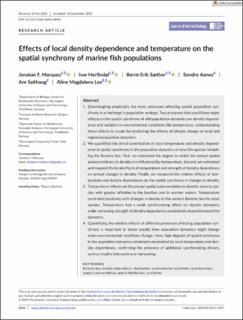| dc.contributor.author | Marquez, Jonatan | |
| dc.contributor.author | Herfindal, Ivar | |
| dc.contributor.author | Sæther, Bernt-Erik | |
| dc.contributor.author | Aanes, Sondre | |
| dc.contributor.author | Salthaug, Are | |
| dc.contributor.author | Lee, Aline Magdalena | |
| dc.date.accessioned | 2023-11-22T08:09:55Z | |
| dc.date.available | 2023-11-22T08:09:55Z | |
| dc.date.created | 2023-10-09T11:06:07Z | |
| dc.date.issued | 2023 | |
| dc.identifier.citation | Journal of Animal Ecology. 2023, 92 (11), 2214-2227. | en_US |
| dc.identifier.issn | 0021-8790 | |
| dc.identifier.uri | https://hdl.handle.net/11250/3103991 | |
| dc.description.abstract | Disentangling empirically the many processes affecting spatial population synchrony is a challenge in population ecology. Two processes that could have major effects on the spatial synchrony of wild population dynamics are density dependence and variation in environmental conditions like temperature. Understanding these effects is crucial for predicting the effects of climate change on local and regional population dynamics. We quantified the direct contribution of local temperature and density dependence to spatial synchrony in the population dynamics of nine fish species inhabiting the Barents Sea. First, we estimated the degree to which the annual spatial autocorrelations in density are influenced by temperature. Second, we estimated and mapped the local effects of temperature and strength of density dependence on annual changes in density. Finally, we measured the relative effects of temperature and density dependence on the spatial synchrony in changes in density. Temperature influenced the annual spatial autocorrelation in density more in species with greater affinities to the benthos and to warmer waters. Temperature correlated positively with changes in density in the eastern Barents Sea for most species. Temperature had a weak synchronizing effect on density dynamics, while increasing strength of density dependence consistently desynchronised the dynamics. Quantifying the relative effects of different processes affecting population synchrony is important to better predict how population dynamics might change when environmental conditions change. Here, high degrees of spatial synchrony in the population dynamics remained unexplained by local temperature and density dependence, confirming the presence of additional synchronizing drivers, such as trophic interactions or harvesting. | en_US |
| dc.language.iso | eng | en_US |
| dc.title | Effects of local density dependence and temperature on the spatial synchrony of marine fish populations | en_US |
| dc.title.alternative | Effects of local density dependence and temperature on the spatial synchrony of marine fish populations | en_US |
| dc.type | Journal article | en_US |
| dc.type | Peer reviewed | en_US |
| dc.description.version | publishedVersion | en_US |
| cristin.ispublished | true | |
| cristin.fulltext | original | |
| cristin.qualitycode | 2 | |
| dc.identifier.doi | 10.1111/1365-2656.14008 | |
| dc.identifier.cristin | 2182808 | |
| dc.source.journal | Journal of Animal Ecology | en_US |
| dc.source.volume | 92 | en_US |
| dc.source.issue | 11 | en_US |
| dc.source.pagenumber | 2214-2227 | en_US |
| dc.relation.project | Norges forskningsråd: 223257 | en_US |
| dc.relation.project | Norges forskningsråd: 244647 | en_US |
